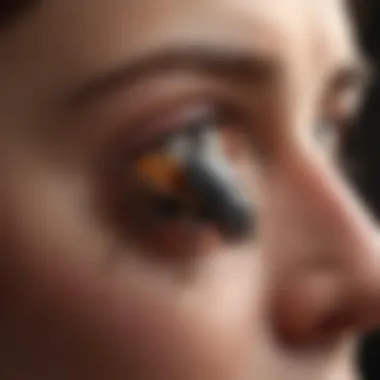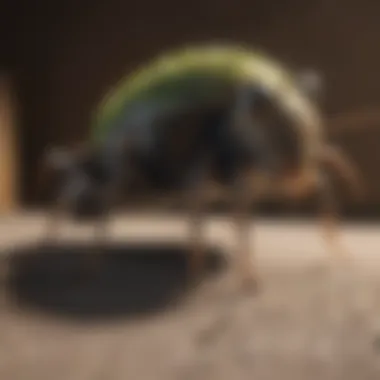Revolutionizing Pest Management: The 3D Pest Control Evolution Unveiled


Preventive Pest Control Strategies
House Exterior Protection
When it comes to pest control, ensuring the exterior of your house is protected is crucial. Simple tips such as sealing cracks effectively can prevent pests from finding their way into your home. Additionally, clearing debris around your property removes potential hiding spots for insects and rodents, making it harder for them to establish a presence. Proactive measures like these can go a long way in preventing infestations.
Yard Maintenance
Maintaining your yard plays a significant role in pest prevention. Implementing essential yard care routines such as regular mowing, trimming, and removing standing water helps keep pests at bay. By creating a pest-free environment in your yard, you reduce the likelihood of pests making their way into your home through outdoor means.
Indoor Cleanliness
Indoor cleanliness is another critical aspect of preventing pest infestations. Using expert cleaning tips and techniques, you can ensure that your indoor environment remains pest-resistant. Regular cleaning and proper maintenance not only promote a healthy living space but also deter pests from establishing colonies indoors.
Garbage Disposal
Efficient waste disposal methods are essential in preventing pests from being attracted to your home. Proper garbage disposal not only maintains a clean environment but also eliminates potential food sources for pests. By securing trash bins and disposing of waste promptly, you can significantly reduce the risk of infestations.
Other Pest Prevention Strategies
Apart from the mentioned strategies, there are innovative ways to safeguard your home from pests. These may include using natural repellents, deploying electronic deterrents, or implementing landscape modifications to deter pests from entering your property.
Introduction
In the realm of pest control, the evolution towards 3D pest control solutions marks a significant advancement in the industry. This article aims to explore how cutting-edge strategies and technologies are reshaping traditional pest management practices by integrating three-dimensional perspectives. By delving into advanced surveillance techniques and precision targeting, professionals are challenging conventional methods to combat infestations in a more efficient and effective manner.


Understanding 3D Pest Control
Defining 3D Pest Control
Defining 3D pest control involves the application of multidimensional approaches to pest management, moving beyond surface-level interventions. This paradigm shift allows professionals to tackle infestations from various angles and depths, offering a more thorough and holistic eradication process. The key characteristic of 3D pest control lies in its ability to analyze pest behaviors and habitats in a three-dimensional space, enabling targeted and precise interventions. The unique feature of this approach is the enhanced efficacy in eradicating pests by mapping out their movements and habitats accurately. While advantageous in providing comprehensive pest management, some potential disadvantages include the complexity of implementation and the need for specialized training.
Importance of Three-Dimensional Perspective in Pest Management
The importance of adopting a three-dimensional perspective in pest management cannot be overstated. By incorporating depth and height into pest control strategies, professionals gain a comprehensive understanding of pest movements and breeding grounds. This holistic approach enhances the efficacy of interventions by addressing infestations in their entirety rather than surface-level treatments. The key characteristic of the three-dimensional perspective is its ability to uncover hidden infestation sources and patterns that conventional methods may overlook. This approach is a popular choice in modern pest management due to its substantial improvement in eradicating pests and preventing future outbreaks. However, a potential disadvantage could be the initial investment required for specialized technology and training.
Evolution of Pest Control Strategies
Traditional Pest Control Methods vs. 3D Approaches
Contrasting traditional pest control methods with 3D approaches reveals a fundamental shift in how pests are managed. While traditional methods often focus on surface-level treatments, 3D approaches delve deeper into the root causes of infestations. The key characteristic of this comparison lies in the precision and effectiveness offered by 3D approaches in targeting pests at their core habitats. Choosing 3D approaches for pest control in this article ensures a more sustainable and thorough approach to managing infestations. The unique feature of these methods is the ability to reduce the reliance on chemical pesticides by understanding and addressing pest behaviors accurately. Although advantageous in promoting environmentally friendly pest control, a potential drawback could be the initial adjustment period required for professionals transitioning from traditional methods.
Technological Advancements Driving Innovation
Technological advancements play a pivotal role in driving innovation within the pest control industry. The integration of cutting-edge technologies enhances the precision and effectiveness of pest management strategies. The key characteristic of technological advancements in pest control is their ability to provide real-time monitoring and data analysis, offering insights for targeted interventions. Choosing this innovative approach for pest control ensures a competitive edge in combating evolving pest species and behaviors. The unique feature of these advancements is the capacity to streamline pest monitoring and eradication processes through automation and data-driven decision-making. While advantageous in improving operational efficiencies, a potential disadvantage could be the initial investment costs associated with acquiring and implementing advanced technologies.
Advanced Surveillance Techniques
In the realm of 3D pest control, advanced surveillance techniques play a pivotal role in revolutionizing the industry and enhancing pest management strategies. The utilization of cutting-edge surveillance methods is crucial in effectively combating infestations and maintaining control over pest populations. By incorporating innovative surveillance technologies, professionals can gather crucial data, monitor pest activities, and implement targeted interventions with precision and efficiency.
Utilizing Drones for Pest Monitoring


Drones have emerged as valuable tools for pest monitoring, offering a unique vantage point and increased capabilities for aerial surveillance. The Benefits of Aerial Surveillance using drones provide unparalleled access to remote or hard-to-reach areas, allowing for comprehensive monitoring of pest populations across diverse landscapes. This advanced technology enables professionals to conduct surveys, track pest movements, and identify infestation hotspots with heightened accuracy and timeliness.
The precision monitoring of pest activities facilitated by drones allows for real-time tracking and analysis of pest behavior. By employing drones equipped with high-resolution cameras and sensors, professionals can detect subtle changes in pest dynamics, enabling proactive decision-making and targeted interventions. This level of precision monitoring enhances the effectiveness of pest control measures, resulting in more efficient resource allocation and optimized management strategies.
Sensor Technologies in Pest Detection
The integration of sensor technologies is revolutionizing pest detection methods, offering early warning systems and enhanced monitoring capabilities. Sensors play a critical role in facilitating early detection of pests by continuously collecting data on environmental conditions and pest behavior. The Integration of Sensors for Early Detection enables professionals to identify potential threats at the onset, allowing for prompt action and mitigation measures to prevent infestations from becoming widespread.
Real-time data analysis for targeted interventions leverages sensor data to generate actionable insights and inform decision-making processes. By utilizing sophisticated data analysis techniques, professionals can pinpoint high-risk areas, prioritize treatment targets, and deploy interventions strategically. This data-driven approach enhances the efficiency and efficacy of pest management protocols, leading to more sustainable and environmentally friendly outcomes.
Precision Targeting and Intervention
Precision targeting and intervention play a pivotal role in the evolution of 3D pest control. In this article, we delve into the significance of precise measures in combating infestations within three-dimensional spaces. By focusing on targeted strategies, professionals can effectively address pest management challenges with a higher level of accuracy and efficiency.
Micro-Scale Pest Control Measures
Nanotechnology Applications in Pest Eradication
Nanotechnology applications offer a groundbreaking approach to pest eradication within the realms of 3D pest control. The essence of nanotechnology lies in its ability to deliver concentrated solutions at the micro-level, targeting pests with remarkable precision. This method proves to be highly effective in eliminating pests while minimizing environmental impact. Nanotechnology applications stand out for their capability to enhance pest control outcomes significantly, making them a preferred choice for innovative pest management strategies.
Targeted Delivery Systems for Effective Treatment
Targeted delivery systems represent a crucial aspect of precise pest intervention techniques. These systems are designed to deliver treatments directly to the affected areas, ensuring maximum efficacy and minimal wastage. By employing targeted delivery, pest control professionals can administer treatments with pinpoint accuracy, optimizing the effectiveness of pest eradication efforts. While targeted delivery systems offer unparalleled precision, their implementation may require specialized knowledge and training to harness their full potential.
Biological Controls in Three Dimensions


Utilizing Natural Predators in 3D Pest Management
Leveraging natural predators forms a cornerstone in three-dimensional pest management strategies. By introducing natural enemies of pests into the ecosystem, professionals promote a natural balance that helps control pest populations organically. The adoption of natural predators presents a sustainable and eco-friendly approach to pest management, reducing the reliance on chemical interventions. Integrating natural predators into pest control regimes requires a deep understanding of ecosystems and careful considerations to ensure effective pest regulation.
Enhancing Ecosystem Balance through Biological Interventions
Enhancing ecosystem balance through biological interventions reinforces the principles of sustainable pest management in 3D spaces. By leveraging biological controls, professionals not only combat pest infestations but also nurture a harmonious ecosystem where natural processes regulate pest populations. This approach enables long-term pest control solutions that benefit both the environment and human health. While biological interventions offer numerous advantages, understanding the intricacies of different organisms' roles within the ecosystem is crucial for successful implementation.
Future Prospects and Sustainability
In the riveting world of 3D pest control, future prospects and sustainability play a pivotal role in shaping the trajectory of the industry. As we delve deeper into this article, it becomes evident that looking ahead and ensuring sustainable practices are essential for long-term success. The intricate balance between innovation and ecological responsibility is highlighted, showcasing how the evolution of pest control is not just about immediate solutions but also about creating a lasting impact.
Emerging Trends in 3D Pest Control
Artificial Intelligence Integration for Predictive Analysis
Artificial Intelligence (AI) integration for predictive analysis stands at the forefront of revolutionizing 3D pest control strategies. By harnessing the power of AI, professionals can analyze vast amounts of data to predict pest behaviors accurately. The key characteristic of AI lies in its ability to continuously learn and adapt, offering dynamic solutions that cater to the ever-changing pest landscape. Its predictive capabilities not only streamline operations but also enhance efficiency, making it a popular choice in this article for its forward-thinking approach.
Innovative Eco-Friendly Solutions for Sustainable Pest Management
The integration of innovative eco-friendly solutions marks a turning point in the quest for sustainable pest management practices. These solutions prioritize environmental consciousness without compromising effectiveness. One key characteristic is their ability to target pests specifically while minimizing harm to beneficial organisms and ecosystems. The unique feature lies in striking a balance between efficacy and sustainability, offering a win-win scenario for both professionals and the environment. Their advantages include reducing chemical usage, promoting biodiversity, and aligning with eco-friendly trends in the industry.
Challenges and Opportunities Ahead
Regulatory Considerations in Advancing 3D Pest Control
Navigating the realm of regulatory considerations is a crucial aspect of advancing 3D pest control initiatives. Compliance with existing laws and regulations ensures that innovation in pest management remains ethically sound and legally valid. The key characteristic of regulatory compliance is its role in providing a framework for responsible practices, safeguarding both professionals and the environment. While the process can be intricate and time-consuming, the advantages are clear in fostering trust with stakeholders and ensuring the sustainability of pest control efforts.
Collaborative Approaches for Industry Growth and Development
Embracing collaborative approaches is vital for fostering industry growth and development in the realm of 3D pest control. By working together across sectors and disciplines, professionals can leverage collective expertise to overcome complex challenges and drive innovation. The key characteristic of collaboration lies in its ability to spark creativity, encourage knowledge sharing, and accelerate progress. The unique feature is in creating a network of support that promotes learning and growth, leading to sustainable solutions that benefit the industry as a whole. Its advantages include pooling resources, sharing best practices, and facilitating holistic approaches to pest management.



